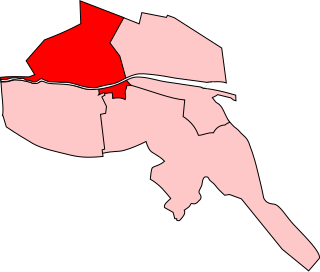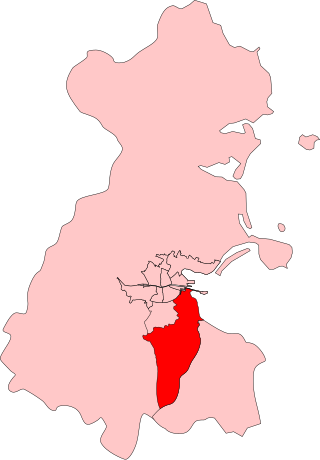History
Prior to the 1885 general election, the city was the undivided two-member Dublin City constituency. Under the Redistribution of Seats Act 1885, Dublin was divided into four divisions: St Patrick's, College Green, Dublin Harbour and St Stephen's Green.
Under the Redistribution of Seats (Ireland) Act 1918, the city was allocated seven seats: in addition to the four existing constituencies, the new divisions were Clontarf, St James's and St Michan's. [4] St Patrick's lost territory to St James's.
Sinn Féin used this election to elect members of Dáil Éireann, inviting all those elected in Ireland to sit as a Teachta Dála (known in English as a Deputy) in the Dáil, although only the Sinn Féin members attended. St Patrick's in 1918 gave Sinn Féin 63% of the vote. Constance Markievicz was the first woman to win a parliamentary election in Britain and Ireland, at the first election where women were permitted to stand as candidates.
Under the Government of Ireland Act 1920, the area was combined with the St Stephen's Green Division to form Dublin South, a 4-seat constituency for the Southern Ireland House of Commons and a single constituency at Westminster. [5] At the 1921 election for the Southern Ireland House of Commons, the four seats were won uncontested by Sinn Féin, who treated it as part of the election to the Second Dáil. Constance Markievicz was one of the four TDs for Dublin South.
Under s. 1(4) of the Irish Free State (Agreement) Act 1922, no writ was to be issued "for a constituency in Ireland other than a constituency in Northern Ireland". [6] Therefore, no vote was held in Dublin South at the 1922 United Kingdom general election on 15 November 1922, shortly before the Irish Free State left the United Kingdom on 6 December 1922.

County Carlow was a parliamentary constituency in Ireland, which from 1801 to 1885 returned two Members of Parliament (MPs) to the House of Commons of the United Kingdom, and one MP from 1885 to 1922.
South Dublin, a division of County Dublin, was a county constituency in Ireland from 1885 to 1922. It elected one Member of Parliament (MP) to the House of Commons of the Parliament of the United Kingdom, using the first past the post voting system.
North Dublin, a division of County Dublin, is a former parliamentary constituency which returned one Member of Parliament (MP) to the House of Commons of the United Kingdom from 1885 until 1922. From 1918 to 1921, it was also used as a constituency for Dáil Éireann. From the dissolution of 1922, the area was not represented in the UK Parliament.
East Down was a UK Parliament constituency in Ireland which returned one Member of Parliament from 1885 to 1922, using the first past the post electoral system.
West Down was a UK Parliament constituency in Ireland which returned one Member of Parliament from 1885 to 1922, using the first past the post electoral system.
Cromac, a division of Belfast, was a UK parliamentary constituency in Ireland. It returned one Member of Parliament (MP) to the House of Commons of the United Kingdom from 1918 to 1922, using the first past the post electoral system.
Duncairn, a division of the parliamentary borough of Belfast, was a UK parliamentary constituency in Ireland. It returned one Member of Parliament (MP) to the House of Commons of the United Kingdom from 1918 to 1922, using the first past the post electoral system.
Falls, a division of Belfast, was a UK parliamentary constituency in Ireland. It returned one Member of Parliament (MP) to the House of Commons of the United Kingdom from 1918 to 1922, using the first past the post electoral system.
Ormeau, a division of Belfast, was a UK parliamentary constituency in Ireland. It returned one Member of Parliament (MP) to the House of Commons of the United Kingdom from 1918 to 1922, using the first past the post electoral system.
Shankill, a division of the parliamentary borough of Belfast, was a UK parliamentary constituency in Northern Ireland. It returned one Member of Parliament (MP) to the House of Commons of the United Kingdom from 1918 to 1922, on the electoral system of first past the post.
St Anne's, a division of Belfast, was a UK parliamentary constituency in Ireland. It returned one Member of Parliament (MP) to the House of Commons of the United Kingdom from 1918 to 1922, using the first past the post electoral system.
Clontarf, a division of the parliamentary borough of Dublin, was a parliamentary constituency which returned one Member of Parliament (MP) to the House of Commons of the United Kingdom from 1918 until 1922. From 1918 to 1921, it was also used a constituency for Dáil Éireann.
St James's, a division of Dublin, was a UK parliamentary constituency in Ireland. It returned one Member of Parliament (MP) to the British House of Commons from 1918 to 1922, using the first past the post electoral system.
St Michan's, a division of the parliamentary borough of Dublin, was a parliamentary constituency which returned one Member of Parliament (MP) to the House of Commons of the United Kingdom from 1918 until 1922, using the first past the post electoral system.. From 1918 to 1921, it was also used as a constituency for Dáil Éireann.

College Green, a division of the parliamentary borough of Dublin, was a parliamentary constituency which returned one Member of Parliament (MP) to the House of Commons of the United Kingdom from 1885 until 1922. From 1918 to 1921, it was also used a constituency for Dáil Éireann

Dublin Harbour, a division of Dublin, was a borough parliamentary constituency in Ireland. It returned one Member of Parliament (MP) to the House of Commons of the United Kingdom from 1885 until 1922. From 1918 to 1921, it was also used as a constituency for Dáil Éireann.

St Stephen's Green, a division of Dublin, was a borough constituency in Ireland. It returned one Member of Parliament (MP) to the United Kingdom House of Commons from 1885 until 1922 on the first past the post electoral system.

Pembroke, a division of County Dublin, was a parliamentary county constituency in Ireland. It returned one Member of Parliament (MP) to the House of Commons of the Parliament of the United Kingdom from 1918 to 1922.
Rathmines, a division of County Dublin based on the urban district of Rathmines and Rathgar, was a parliamentary constituency in Ireland. It returned one Member of Parliament (MP) to the House of Commons of the Parliament of the United Kingdom from 1918 to 1922.






